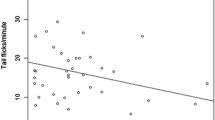Abstract
Many vertebrate species show display behaviors when predators are in their vicinity. Some of these displays may inform the predator of the improbability of capturing the prey (i.e., pursuit-deterrent displays) and are potentially advantageous to both predator and prey. Here we present data on a tail display performed by Gonatodes albogularis, a diurnal tropical gecko. We performed transect surveys in three habitats near Bogotá in Colombia. Geckos detected during transects were approached by the observer in a standardized way, and details of their tail-waving displays were recorded. In control recordings animals were watched from a distant site without approaching them. Results showed sexual differences in tail-waving display: when approached by the observer, males performed this behavior more frequently than females. We found no significant differences between males and females in flight-initiation distances and height above the substratum when they were initially located. Results also showed that males displayed more frequently when approached than when the simulated predator remained stationary. We interpret these results as evidence that the display functions as a pursuit-deterrent signal to potential predators. However, as some tail displays were performed in the presence of conspecifics, the display may also have a social function.



Similar content being viewed by others
References
Alvarez F (1993) Alertness signalling in two rail species. Anim Behav 46:1229–1231
Arnold EN (1984) Evolutionary aspects of tail shedding in lizards and their relatives. J Nat Hist 18:127–169
Arnold EN (1988) Caudal autotomy as a defense. In: Gans C, Huey RB (eds) Biology of the reptilia. Ecology B. Defense and life history, vol 16. Alan R. Liss, New York, pp 235–276
Bello RE (2000) Anolis sp and Gonatodes albogularis (yellow-headed gecko). Predation. Herpetol Rev 31:239–240
Bustard HR (1965) Observations on Australian geckos. Herpetologica 21:294–302
Caro TM (1986) The function of stotting: a review of hypotheses. Anim Behav 34:663–684
Caro TM (1995) Pursuit-deterrence revisited. TREE 10:500–503
Caro TM, Graham CM, Stoner CJ, Vargas JK (2004) Adaptive significance of antipredator behaviour in artiodactyls. Anim Behav 67:205–228
Clark RW (2005) Pursuit-deterrent communication between prey animals and timber rattlesnakes (Crotalus horridus): the response of snakes to harassment displays. Behav Ecol Sociobiol 59:258–261
Colli GR, Mesquita DO, Rodrigues PVV, Kitayama K (2003) Ecology of the gecko Gymnodactylus geckoides amarali in a Neotropical Savanna. J Herpetol 37:694–706
Cooper WE Jr (1998) Reactive and anticipatory display to deflect predatory attack to an autotomous lizard tail. Can J Zool 76:1507–1510
Cooper WE Jr (2001) Multiple roles of tail display by the curly-tailed lizard Leiocephalus carinatus: pursuit deterrent and deflective roles of a social signal. Ethology 107:1137–1149
Cooper WE Jr (2007) Escape and its relationship to pursuit-deterrent signalling in the Cuban curly-tailed lizard Leiocephalus carinatus. Herpetologica 63:144–150
Cooper WE Jr, Frederick WG (2007) Optimal flight-initiation distance. J Theor Biol 244:59–67
Cooper WE Jr, Pérez-Mellado V, Baird T, Baird TA, Caldwell JP, Vitt LJ (2003) Effects of risk, cost, and their interaction on optimal escape by nonrefuging Bonaire whiptail lizards, Cnemidophorus murinus. Behav Ecol 14:288–293
Cooper WE Jr, Pérez-Mellado V, Baird TA, Caldwell JP, Vitt LJ (2004) Pursuit deterrent signalling by the Bonaire whiptail lizard Cnemidophorus murinus. Behaviour 141:297–311
Croft DP, Morrell LJ, Wade AS, Piyapong C, Ioannou CC, Dyer JRG, Chapman BB, Wong Y, Krause J (2006) Predation risk as a driving force for sexual segregation: a cross-population comparison. Am Nat 167:867–878
Demeter BJ, Marcellini DL (1981) Courtship and aggressive behaviour of the streak lizard (Gonatodes vittatus) in captivity. Herpetologica 37:250–256
Dial BE (1986) Tail display in two species of iguanid lizards: a test of the ‘predator signal’ hypothesis. Am Nat 127:103–111
Dial BE, Fitzpatrick LC (1984) Predator escape success in tailed versus tailless Scincella lateralis (Sauria: Scincidae). Anim Behav 32:301–302
Dial BE, Weldon PJ, Curtis B (1989) Chemosensory identification of snake predators (Phyllorhynchus decurtatus) by banded geckos (Coleonyx variegatus). J Herpetol 23:224–229
Downes S, Shine R (1998) Sedentary snakes and gullible geckos: predator–prey coevolution in nocturnal rock-dwelling reptiles. Anim Behav 55:1373–1385
Ellingson JM (1994) Natural and sexual selection on coloration in the diurnal gecko Gonatodes albogularis. Unpublished Ph.D. thesis, University of Texas at Austin, USA
Fitch HS (1973) A field study of Costa Rican lizards. Univ Kans Sci Bull 50:39–126
Gillespie TW, Grijalva A, Farris CN (2000) Diversity, composition, and structure of tropical dry forests in Central America. Plant Ecol 147:37–47
Godin JG, Davis SA (1995) Who dares benefits: predator approach behaviour in the guppy (Poecilia reticulata) deters predator pursuit. Proc R Soc Lond B 259:193–200
Greene HW (1988) Antipredator mechanisms in reptiles. In: Gans C, Huey RB (eds) Biology of the reptilia. Ecology B. Defense and life history, vol 16. Alan R. Liss, New York, pp 1–152
Harris DM, Kluge AG (1984) The Sphaerodactylus (Sauria: Gekkonidae) of Middle America. Occas Pap Mus Zool Univ Mich 706:1–59
Hasson O, Hibbard R, Ceballos G (1989) The pursuit deterrent function of tail-wagging in the zebra-tailed lizard (Callisaurus draconoides). Can J Zool 67:1203–1209
Hawlena D, Boochnik R, Abramsky Z, Bouskila A (2006) Blue tail and striped body: why do lizards change their infant costume when growing up? Behav Ecol 17:889–896
Holdridge LR, Grenke WC, Hatheway WH, Liang T, Tosi JA (1971) Forest environments in tropical life zones: a pilot study. Pergamon Press, Oxford
Husak JF, Macedonia JM, Fox SF, Sauceda RC (2006) Predation cost of conspicuous male coloration in collared lizards (Crotaphytus collaris): an experimental test using clay-covered model lizards. Ethology 112:572–580
IDEAM (2000) http://www.ideam.gov.co/
Johnson JA, Brodie ED (1974) Defensive behaviour of the western banded gecko, Coleonyx variegatus. Anim Behav 22:684–687
Langkilde T, Schwarzkopf L, Alford RA (2004) The function of tail displays in male rainbow skinks (Carlia jarnoldae). J Herpetol 39:325–328
Leal M (1999) Honest signalling during prey–predator interactions in the lizard Anolis cristatellus. Anim Behav 58:521–526
Leal M, Rodríguez-Robles JA (1997a) Signalling displays during predator–prey interactions in a Puerto Rican anole, Anolis cristatellus. Anim Behav 54:1147–1154
Leal M, Rodríguez-Robles JA (1997b) Antipredator responses of the Puerto Rican giant anole Anolis cuvieri (Squamata: Polychrotidae). Biotropica 29:372–375
Leuck BE, Hughes KW, Cheng HY (1990) Social displays of experimentally paired dwarf geckos (Sphaerodactylus clenchi). J Herpetol 24:416–418
Marcellini D (1977) Acoustic and visual display behavior of gekkonid lizards. Am Zool 17:251–260
Miranda JP, Andrade GV (2003) Seasonality in diet, perch use, and reproduction of the gecko Gonatodes humeralis from eastern Brazilian Amazon. J Herpetol 36:433–438
Mori A (1990) Tail vibration of the Japanese grass lizard Takydromus tachydromoides as a tactic against a snake predator. J Ethol 8:81–88
Murphy TG (2006) Predator-elicited visual signal: why the turquoise-browed motmot wag-displays its racketed tail. Behav Ecol 17:547–553
Plasman M, Duchateau MJHM, Macedonia JM (2007) Anti-predation behaviour of Dickerson’s collared lizard, Crotaphytus dickersonae. Anim Biol 57:231–246
Randler C (2006) Is tail wagging in white wagtails, Motacilla alba, an honest signal of vigilance? Anim Behav 71:1089–1093
Randler C (2007) Observational and experimental evidence for the function of tail flicking in Eurasian Moorhen Gallinula chloropus. Ethology 113:629–639
Rivero-Blanco C (1979) The neotropical lizard genus Gonatodes Fitzinger (Sauria: Spherodactylinae). Unpublished Ph.D. thesis, Texas A&M University, College Station, Texas, USA
Ruxton GD, Speed M, Sherratt TN (2004) Avoiding attack: the evolutionary ecology of crypsis, warning signals and mimicry. Oxford University Press, Oxford
Shine R, Olsson MM, LeMaster MP, Moore IT, Mason RT (2000) Effects of sex, body size, temperature, and location on the antipredator tactics of free-ranging gartersnakes. Behav Ecol 11:239–245
Sokal RR, Rohlf FJ (1995) Biometry: the principles and practice of statistics in biological research, 3rd edn. Freeman, New York
Stankowich T, Blumstein DT (2005) Fear in animals: a review and meta-analysis of risk assessment. Proc R Soc Lond B 272:2627–2634
Stankowich T, Coss RG (2006) Effects of predator behavior and proximity on risk assessment by Columbian black-tailed deer. Behav Ecol 17:246–254
Stuart-Fox DM, Moussalli A, Marshall NJ, Owens IPF (2003) Conspicuous males suffer higher predation risk: visual modelling and experimental evidence from lizards. Anim Behav 66:541–550
Vanhooydonck B, Herrel A, Irschick DJ (2007) Determinants of sexual differences in escape behavior in lizards of the genus Anolis: a comparative approach. Integr Comp Biol 47:200–210
Vitt LJ, Congdon JD, Dickson NA (1977) Adaptive strategies and energetics of tail autotomy in lizards. Ecology 58:326–337
Whitaker PB, Shine R (1999) Responses of free-ranging brownsnakes (Pseudonaja textiles: Elapidae) to encounters with humans. Wildl Res 26:689–704
Woodland DJ, Jaafar Z, Knight ML (1980) The ‘pursuit deterrent’ function of alarm signals. Am Nat 115:748–753
Ydenberg RC, Dill LM (1986) The economics of fleeing from predators. Adv Stud Behav 16:229–249
Acknowledgments
We thank the Universidad Católica de Colombia for funding to perform the study. Universidad Externado de Colombia also supported some logistic actions. We also thank the students Cristian Camilo Rincón Mendieta, Diego Armando Plazas Burgos, Diana Marcela Rojas Lara, and Jorge Alberto Cure Arango, and Professor M.L. Calderón for their help during logistic operations in the field. The International Relationships Office of the University of La Laguna provided financial support for the travel of M. Molina-Borja to Colombia to participate in the research.
Author information
Authors and Affiliations
Corresponding author
About this article
Cite this article
Bohórquez Alonso, M.L., Martínez Cotrina, J., Aguilar Pardo, D. et al. Sex differences in antipredator tail-waving displays of the diurnal yellow-headed gecko Gonatodes albogularis from tropical forests of Colombia. J Ethol 28, 305–311 (2010). https://doi.org/10.1007/s10164-009-0186-4
Received:
Accepted:
Published:
Issue Date:
DOI: https://doi.org/10.1007/s10164-009-0186-4




